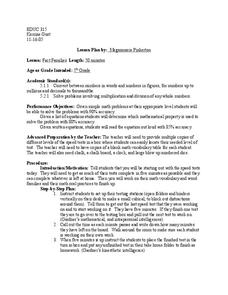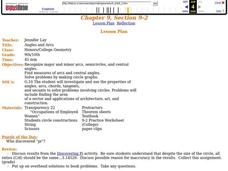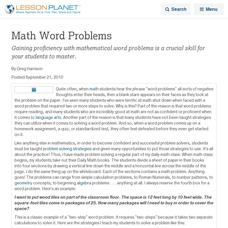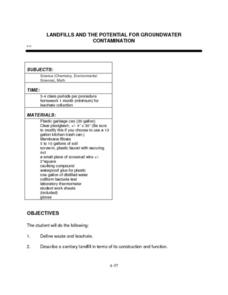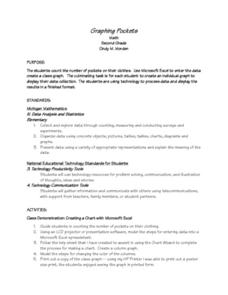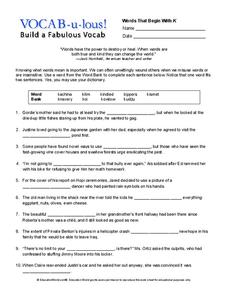Curated OER
Fact Families
Fifth graders explore fact families. They solve simple math problems. Students determine which mathematical property is used to solve the given problem. They are given five minutes to complete as many mathematical facts as possible.
Curated OER
Angles and Arcs
Students discuss the sum of central angles and use string to create them on circles. They find the measure and length of both minor and major arcs.
Students give examples of concentric, similar, and congruent circles and congruent arcs.
Curated OER
Handling Data: Probability
Fourth graders find and justify probabilities and approximations. In this repeating experiment, 4th graders complete a worksheet after rolling die and tossing coins to determine outcomes.
Curated OER
Number: Time
Students calculate time in decimals and fractions. In this time lesson, students divide hours into equal sections. They discuss how fractions and decimals correspond to hours and minutes.
Curated OER
Handling Data: Comparing Distributions
Students gather information by analyzing graphs, diagrams and pie charts. In this graphs and diagrams lesson, students complete addition and subtraction problems. Students discuss a pie chart. Students use information to crate a stacked...
Curated OER
Inscribed Angles
Students analyze inscribed angles and intercepted arcs and explore the relationships between the two. They investigate the properties of angles, arcs, chords, tangents, and secants to solve problems involving circles.
Curated OER
Edit a Friendly Letter
In this letter editing worksheet, learners read a letter to "mom," then recopy it on another sheet of paper and correct all errors found.
Curated OER
Math Word Problems
Gaining proficiency with mathematical word problems is a crucial skill for your students to master.
Curated OER
Where Does All the Money Go?
Students explore the concept of uses for money. In this uses for money lesson, students discuss ways in which money can be utilized such as spending, saving, investing, donating, etc. Students discuss the differences between needs and...
Curated OER
Our Solar System to Scale
Students calculate the diameter of planets and their relative distances. In this space science activity, students discover how small or big the planets are in comparison to each other. Students use cross multiplying fractions to...
Curated OER
Follow That Graph
Learners investigate the graphs of six trigonometric functions. They discover how changes in the equation of the basic function affect the graph of the function.
Curated OER
Landfills and the Potential for Groundwater Contamination
Learners examine how a sanitary landfill is constructed, how it functions, and how waste and leachate affects the areas around the landfill. After a discussion about landfills and leachates, students construct a Sanitary Landfill Model...
Curated OER
Using Statistics to Uncover More Evidence
Fifth graders participate in an online Web lesson plan on ways of interpreting data. They conduct a survey and interpret the results in a journal entry.
Curated OER
Graphing Pockets
Second graders explore graphing. They count the number of pockets on their clothes and use Microsoft Excel to enter their data. Students create a class graph displaying their findings.
Curated OER
Grammar Bytes - Parallel Structure
The first exercise in a series of worksheets, this handout asks learners to read 10 sets of sentences and choose the one with no errors in structure. Tip: Find all of the worksheets on parallel structure throughout our website and create...
Curated OER
Transportation Systems: Two Liter Boat Activity
Young scholars design and build full-size boats made out of two-liter plastic bottles, chicken wire, and plywood. Then they race the boats, with the boat's designers "manning the hull", in the school's swimming pool.
Howard Hughes Medical Institute
What van Leeuwenhoek Saw
When van Leeuwenhoek saw cells and single-celled organisms for the first time, he knew these small things were a big deal! Share his discoveries with young learners through a narrated video, model-building activity, and scale study....
Curated OER
Dr. Seuss’s ABC: An Amazing Alphabet Book Lesson
Dr. Seuss's ABC Book is used to help young readers distinguish between the letters of the alphabet and their letter sounds. After a discussion reviewing the letters that are vowels and consonants, the book is read to the class. Then, the...
Boys Town
More Tools for Teaching Social Skills in School
Put an end to wasted instructional time with this instructional activity on responsibility and preparedness. After completing this series of activities students will learn the importance of these social skills not only in the...
Curated OER
Grand Canyon History Lesson
Students explore the history of the Grand Canyon. In this Grand Canyon lesson plan, students read "Grand Canyon National Park" by David Peterson and respond to questions regarding the piece. Students also create their own fossil models...
Curated OER
Vocab-u-lous! Build a Fabulous Vocab
In this vocabulary worksheet, learners determine the best choice from the word bank to complete the sentence. All words are challenging and start with the letter "K."
Curated OER
Long-Term Goals
Students identify long and short term goals. In this perseverance lesson, students discuss the difference between short term and long term goals. Students categorize their personal goals as short or long term. Students read a quote by...
Curated OER
Batteries in Series: Voltage and Light Intensity
Students participate in a hands-on activity to explore the relationship between the number of batteries in a series circuit and its voltage. Students identify the relationship between two variables and plot points on a graph.
Curated OER
A Day in the Life of an Employed Child
Second graders compare/contrast their lives with those of children who work. They develop a generic daily schedule of their activities, compare it with the daily schedule of a child that is employed, and answer discussion questions.


